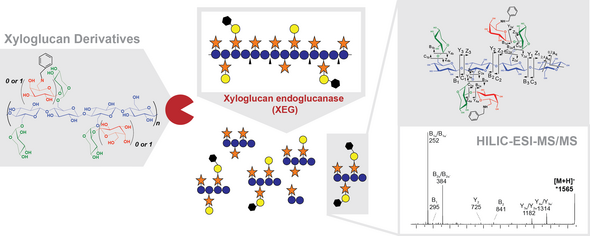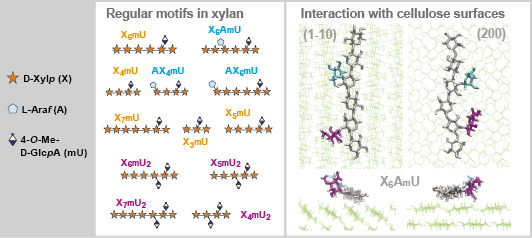Research Interests
1) MS-based glycomic methods for carbohydrate structural elucidation
The complete structural determination of native polysaccharides at the molecular level is far from being implemented, as it is routinely done for the primary structure of nucleic acids and proteins through common genomic, transcriptomic, and proteomic sequencing techniques. We are developing analytical tools for deciphering the molecular structure of complex biomass glycans (polysaccharides) using selective carbohydrate-active enzymes, multidimensional chromatography and mass spectrometry.

Picture modified from Journal of Chromatography A (2016), 1463, 110
A novel area of research is to implement methods for understanding the glycosylation pattern in therapeutic glycoproteins, with fundamental implications for binding, stability and function.
2) Understand the molecular structure and supramolecular architecture of eukaryotic cell walls (plants and fungi)
We believe that the heterogeneous nature of matrix polysaccharides influences the multiscale assembly of plant and fungal cell walls and contributes to their recalcitrance towards further exploitation. Due to its importance and abundance in the Nordic countries, we are focusing on understanding the architecture of secondary cell walls from softwoods, hardwoods, and grasses. Within the framework of the Wallenberg Wood Science Center, we are investigating the substitution pattern of wood hemicelluloses (xylans, mannans) and their effect on the interactions with cellulose and lignin.

Regular motifs in spruce xylan and their role on the interactions with cellulose surfaces. Figure modified from Plant Physiology (2017).
3) Application of carbohydrate-active enzymes in biomass processing ('biorefineries')
We are developing cascade processes for the extraction and purification of bioactive polysaccharides from different biomass streams. Our vision is to design biorefineries with zero waste generated using preferably lignocellulosic streams or by-products from food/agricultural streams. In our process design we focus on the use of green solvents (e.g. subcritical water) and selective biocatalysts such as carbohydrate-active enzymes (CAZymes) to overcome the recalcitrance of lignocellulose biomass. In this direction, we are interested in understanding the selectivity and substrate specificity of CAZymes (e.g. glycosyl hydrolases and esterases) that tackle hemicelluloses and other matrix polysaccharides.
Picture modified from Journal of Applied Polymer Science (2016) 133, 2
4) Design of bioactive carbohydrate-based materials and additives.
The purified polysaccharides obtained through our biorefinery processes can be exploited for the design of multifunctional bio-based materials and additives. We use chemo-enzymatic methodologies to tailor the molecular structure and macroscopic properties of the polysaccharides, with potential applications as structural materials or in the food and biomedical sectors. These carbohydrate-based functional materials and additives will potentially be able to replace current fossil-based alternatives on the road towards a bio-based economy.
5) Nutritional benefits of dietary polysaccharides
The molecular structure of energy-reserve (starch) and dietary fibre polysaccharides (beta-glucans, arabinoxylans) influences their digestibility in the gastrointestinal tract and their nutritional benefits. We are interested in exploring the links between dietary polysaccharides and their health effects. Moreover, we are also researching the link between glycogen architecture and diseases such as obesity and diabetes, in collaboration with the Centre for Nutrition and Food Sciences (CNAFS) at the University of Queensland (Australia) with Prof. Robert G. Gilbert and Dr. Mitchell Sullivan.